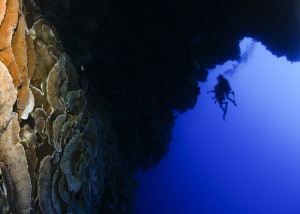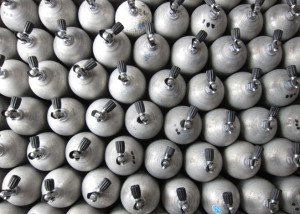Liveaboard: Diving in Indonesia Aboard the Komodo Dancer
A train of four giant mantas charges overhead, and it’s not a freak encounter. The site’s full name is Manta Alley, but superstition has local guides simply calling it the Alley lest the wonders fail to appear, which is rare. Right now, 15 of them — each roughly 12 feet across — are winging laps around Langkoi Rock, a craggy pinnacle of the south side of Komodo, the Indonesian island best known among nondivers for dragons. As for the mantas, they’re here when cold water is, pushing in plankton. And the action is nonstop.
Being in the shadow of beings so large and powerful is humbling. It’s why Noh Atta Abola, steering mate of the M/V Komodo Dancer, is kneeling on the sand, arms overhead. He can’t help the visceral gesture of awe.
The big stuff, from mantas to mola mola, is just part of the reason experienced divers consider Indonesia — and this luxury vessel — the trip of a lifetime. It’s a reward best appreciated after countless hours logged over reefs, learning to identify enough fish species to appreciate the record-setting biodiversity of this underwater Amazon. Moreover, participants need skills honed for the sometimes challenging conditions, from down-currents to drift dives ending in open water.
The 10-day voyage I’ve just begun starts on the island of Flores, 36 hours by boat if traveling nonstop to the end point of Bali, itself a destination most lengthen their trips to experience. Before I embarked, I had wanted to revel in the magic of the place, devoting a week to touring the incense-heavy temples —local myth alleges Bali has a thousand.
The dive trip will be a whirlwind. The itinerary promises a parade of wonders so large it’ll take work to keep pace, and so small it’s a hunt to acknowledge their presence. I imagine it’ll feel much like standing before the ornate temple altars — like what Abola experienced today: a feeling of awe so overwhelming you can’t help but be brought to your knees.
NIGHTLY SHOWINGS
It’s just after sunset, and Rob Morgan-Grenville is briefing us on a site called Circus, supposedly one of the trip’s best night dives. But after he uses the words sand, rock and coral rubble, I debate tugging on a damp wetsuit.
“It’s not the pretty corals we’ve been seeing all week,” Morgan-Grenville admits, referring to sites like Crystal Rock, where every inch of coral is alive, supporting anthias and schools of rainbow runners so thick they obscure any divers among them in the water column.
But muck diving is one of the main attractions of Indonesia. The only possible reason to skip it is a cold Bintang beer — unlimited for guests. But the stocked fridge will wait, so I opt in.
We start by hunting stargazers. Earlier, guide Gede Merta had shown pictures: The fish buries itself in the muck. Only its face — bug eyes and a frowning underbite of corn-kernel teeth — is visible.
I find nothing but broken coral bits until he shakes his dive light, commandeering our attention. Then he aims a wire pointer at the black sand.
The alien is no bigger than a baseball. It’s a lesson repeated when Merta points out a bobtail squid, no bigger than a bumblebee. I think it’s a juvenile till later that night, when we gather in the salon to pore over the Reef Creatures book.
Turns out, bobtail squid are no bigger than golf balls, making their sparkling iridescence somehow more magical.
And so the next few days and nights pass, muck diving at sites such as Fuzzy Bottom of Sumbawa Island. We’re treated to encounters with algae octopuses, dragon sea moths, spiny devilfsh and Bobbitt worms — all of which we truly only appreciate when Merta shows us those pages. And he would know. On the book’s credit page, Merta is listed among eight dive guides whom authors Paul Humann and Ned DeLoach thank for helping them locate the critters.One thing not mentioned in the book: Merta has even discovered a few species.
PRAYING FOR GREATNESS
It’s the last day of the dive trip, and Merta and Morgan-Grenville can’t seem to agree. We’re at Gili Tepekong, an island of the southeast coast of Bali — and just hours from where the yacht will harbor for the final night. This area is known for mola mola, aka ocean sunfish, but the season for seeing them extends only from roughly June to October. Right now, it’s April.
“It’s too early — we don’t have a prayer,” Morgan-Grenville tells us, not wanting to get our hopes up.
“They’re there,” says Merta.
And now, at 78 feet under the surface, Morgan-Grenville is gesturing wildly with his free hand, flashing a thumb up, while gripping his camera with the other.
We all fin deeper, and there, at 100 feet, is a mola mola, glowing white as the moon. Its apple-size eye follows us, its tiny mouth pursed in a pucker.
As I stare at it, and it stares back, I have to laugh. In a way, I’m not surprised. This is Bali, the land of a thousand temples and a population dedicated to its gods. With so much devotion, it’d be wrong not to expect at least a few miracles.
FIVE REASONS TO DIVE KOMODO DANCER
Tender Diving. All sites are accessed by tenders, facilitating drift diving and access to offshore pinnacles.
Local Flavor. The lunch buffet is a highlight, when the chef prepares spiced fish cakes, vegetable curries, beef satays, banana fritters and more.
Komodo Dragons. During much of the trip, no other boats are in sight. When Komodo Dancer moors of its namesake island, visiting these killers is as easy as a dinghy ride.
Day Excursions. Take time for optional land- based excursions, including a pink beach without a soul on it.
Stay for Ubud. Add a day or two to explore Ubud in Bali’s interior. You’ll tour temples, including one of the most famous,the Sacred Monkey Forest Sanctuary, home to 600 macaques.
NEED TO KNOW
When to Go
M/V Komodo Dancer devotes most of the year to seven- and 10-day treks between Bali and Labuan Bajo, on the west coast of Flores. In October and November, itineraries travel between Flores and Alor, giving guests the chance to dive with whales, plus muck critters like wonderpus, blue-ringed and starry-night octopuses.
Dive Conditions
The southern region has greener waters with temperatures ranging from 72 to 77 degrees; it’s where manta sightings are much more frequent. The northern region sees visibility of 100 feet or more, and water temperatures around 82 degrees are standard.
Operator
The 124-foot Komodo Dancer accommodates 16 guests in eight staterooms: two owner suites, two cabins with full-size beds, and the rest with bunk beds.
Price Tag
Rates start at $2,700 for seven nights, double occupancy. Deluxe and master suites are also available. Nitrox upgrades cost $100 for seven days, and $150 for 10 days.
Click here for more information on bucket-list liveaboard adventures, and make sure to check out special discount pricing for a trip aboard Komodo Dancer
Liveaboard: Diving in Indonesia Aboard the Komodo Dancer Read More »
 Why do some dive sites seem prone to more accidents?
Why do some dive sites seem prone to more accidents?
 Here’s a brief review to help you tell your aluminum from your steel and your DIN from your yoke.
Here’s a brief review to help you tell your aluminum from your steel and your DIN from your yoke.